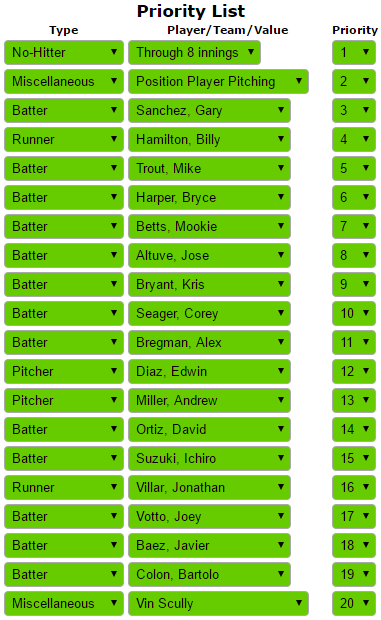Get familiar with MLB.TV Game Changer, a beautiful hack that serves up only high-stakes hardball action – The Ringer (blog)
 No successful sports league publicly apologizes for its play as often as Major League Baseball. Almost weekly, MLB commissioner Rob Manfred reaffirms his commitment to trimming the fat from the game: less time between pitches, less time between innings, and fewer pitching changes; maybe not fewer innings, but fine, fewer games. Baseball is the big eater who’s living large but perpetually promising that a diet is about to begin.
No successful sports league publicly apologizes for its play as often as Major League Baseball. Almost weekly, MLB commissioner Rob Manfred reaffirms his commitment to trimming the fat from the game: less time between pitches, less time between innings, and fewer pitching changes; maybe not fewer innings, but fine, fewer games. Baseball is the big eater who’s living large but perpetually promising that a diet is about to begin.
Many devoted fans don’t care if baseball cuts back; for them, the attraction remains strong, even if the sport has put on a few pounds. But the impulse to appeal to potential fans by curbing the sport’s excesses is sound. As the only American megasport not governed by a clock, baseball tends toward entropy. Last year, the league instituted several time-saving measures and sliced several minutes from its inflated 2014 game times. This year, without rolling back the new rules, MLB has given back half of those gains, which makes it more likely that the pitch clock successfully installed at Double-A and Triple-A in 2015 will soon be coming to a big league ballpark near you.
Pacing is only part of the perceived problem; perhaps more seriously, the vast supply of the sport runs the risk of exceeding demand. There’s more actual action in the typical baseball game than there is in the typical football game, but football is a scarce resource: NFL teams play once per week and 16 times per season. Baseball teams play 162 times, and, until October, no lone outcome moves the needle that much. Regular-season baseball is about incremental progress toward a distant goal, which makes it impossible to provide the same second-by-second excitement.
Unless there were a way to amp up the sport’s suspense. Imagine baseball with the slow sections edited out: scores always close, runners almost always on base, the most popular players more often at the plate or pitching. If that sounds like something you might be interested in, Mr. Manfred, I’ve got good news: The internet has fixed that for you.
Last year, Dan Brooks of the pitch-tracking site Brooks Baseball wrote a simple script that he called MLB.TV Redzone, a nod to the popular NFL RedZone channel that cuts to live action whenever a team enters scoring range. The Redzone script made each user’s MLB.TV seem almost sentient, turning it into a suspense-seeking missile. Relying on a constant stream of stats and scores from MLB’s “Gameday” data feed, Redzone calculated every game’s leverage index — a measure of how critical (and thus, how pressure-packed) any scenario in a given game is — in real time. When the leverage index of another game exceeded that of the game the viewer was watching, Redzone instructed MLB.TV to switch to the higher-LI event.
Redzone was exciting but bare-bones, single-minded in its pursuit of high stakes. Earlier this season, Dan Hirsch, proprietor of historical stats and analysis site The Baseball Gauge, built on Brooks’s concept and assembled a more fully featured script, which he recently renamed the “MLB.TV Game Changer.” (Get it?) I tried Game Changer for a few days last week, which was enough to make me a convert, although your mileage may vary depending on the way you watch the sport.
Unlike Redzone, Game Changer is highly customizable. You can set it to ignore blacked-out games in your local market, and you can tell it to consider not only leverage index, but also championship leverage index, a variant that takes the standings into account. With CLI enabled, you’ll see much more action between contending teams and a lot less Reds vs. Angels (tonight at 10:05 ET!). You can also assign custom priorities to any number of individual hitters, pitchers, base runners, and teams, as well as to certain conditions that will trigger a switch (position players pitching, extra-inning games, no-hitters of a user-selected length, or even games called by Vin Scully). Every two seconds, Game Changer scans the league to see if some other game’s grass is greener. Whenever it finds one with an LI or CLI that surpasses that of the one you’re watching, or a condition that satisfies one of your preset priorities, Game Changer will tune into the more intriguing event, either after the current at-bat or (if you don’t want to wait) immediately.
Here’s where I’m probably supposed to say something ornery about millennials and attention spans and the death of delayed gratification. A case could be made that baseball’s lows are what make its highs so special — that without the winding buildup that brings you to the make-or-break moment, the eventual payoff pales. And yes, if you watched baseball exclusively through the Game Changer, you’d lose a lot: a deep identification with any one team; a feel for how the starting pitcher adjusts his approach each time through the lineup; Keith Hernandez discussing yo-yo tricks.
Countervailing those losses, though, is the allure of baseball that’s never boring: no lopsided leads, no mop-up men, and (almost) no commercials. Game Changer abridges baseball, reducing it to a string of memorable moments that might end up making a postgame recap. Hirsch estimates that the average leverage index of the Game Changer’s selections (user presets aside) falls between 1.5 and 2.0, or 50–100 percent more exciting than run-of-the-mill baseball. (Only 10 percent of plays have an LI greater than 2.0.) As games draw toward their conclusions, the average intensity rises. There’s rarely a great time for a bathroom break, in perhaps the best of all bathroom-break sports.
Some might find it disorienting to sightsee this way, flitting from one tableau to the next as if watching the sport through a strobe light. I found it refreshing, for a few buffering seconds, not to know what I’d be watching when the wheel stopped spinning. Hirsch is testing a display option that will make it more clear why the Game Changer is redirecting to a given game, but it’s fun to figure it out from context. Glance at the chyron and take in the tight score and packed base paths; scan the mound and the batter’s box and ride the thrill of recognition: Hey, there’s [insert superstar here]! One of baseball’s drawbacks, at least from a fan-interest/marketing perspective, is that there’s no way to force its stars to center stage at high-drama moments; a team can’t send its best hitter up with the game on the line unless the batting order allows it. But the Bizarro baseball you watch with the Game Changer can become a parade of high-profile veterans and the streaking rookies trying to steal their spotlight, based on your version of my hitter-heavy pref list. Or you can bend baseball to your will, stacking your list with high-contact hitters and pretending strikeout rates aren’t skyrocketing, or loading up on sluggers and drafting your own home run derby.

The Game Changer experience suffers from a few hiccups, all of which can be traced to its roots as a fan-made hack, rather than a first-party product with native support. For one, it works on web browsers only, so it isn’t compatible with MLB.TV apps on streaming devices. You can connect your computer to your TV for a more app-like experience, but you’ll have to keep clicking to resize the window to full screen every time it changes broadcasts. A more troublesome quirk is that the game-hopping isn’t completely consistent: Because the delay between the Gameday and MLB.TV feeds isn’t always the same, some switches occur right after plate appearances complete, while others require relatively brief but annoyingly indeterminate waits. In two cases — pitching changes and game-ending events — the Gameday feed doesn’t send out a signal immediately, which means you’ll be forced to sit through advertisements like some sort of primitive from the pre-DVR era.
Those defects don’t spoil the Game Changer, but they do highlight how it could be better if MLB embraced the idea and engineered fixes for its few failings. The concept clearly has some appeal to MLB bigwigs; in 2012, MLB Network launched a Red Zone–reminiscent channel called Strike Zone, which features continual live look-ins. Strike Zone is still a niche product: It isn’t included in standard cable packages, and it airs on only Tuesday and Friday nights, when MLB Network broadcasts games live. Nor does MLB.TV offer any automatic switching; although the service added a player tracker intended to help fantasy owners monitor their teams, it’s limited to popups that unobtrusively tip off the viewer when something is happening they might not want to miss. MLB.TV is a pioneering and fan-friendly product, and the tech behind it is a windfall for the league. With a Game Changer–esque option, it could be even more than that, a gateway drug for the neophyte fans that the sport is trying to attract. An MLB Advanced Media spokesman said Game Changer “seems like a cool thing for MLB.TV subscribers,” but that he’d need to know more before commenting further.
If you already love baseball, you don’t need constant suspense; the sport is a comforting companion in whose rhythms you rest secure. Those aspects of the sport are still there when you want them, but Game Changer could help introduce the doubters to baseball’s less-accessible elements. It also makes a worthwhile (and educational) companion for traditionalists: If you’re quaint enough to have cable, you can watch your local team on TV and use Game Changer on your second screen.
Regular-season baseball is a slow burn that’s extinguished and rekindled after each rally. Warming myself at the bonfire without fanning the flames made me feel like an undeserving dilettante who hadn’t earned the rush of run-scoring, but it also made it hard to turn away. To keep pace with the competition, baseball has to balance its big-sample essence with the need to be buzzy: Making one wild-card game decide a team’s season is as much a perturbation of baseball as a tool that skips straight to the climactic moments — but it’s a big ratings draw. Better yet, it’s a way to tie fans together — to watch a game that’s grown more regional, and to feel, alone in your living room, at one with millions, all locked in their white-knuckle worlds.




